Geographic Indications and International Trade (GIANT)
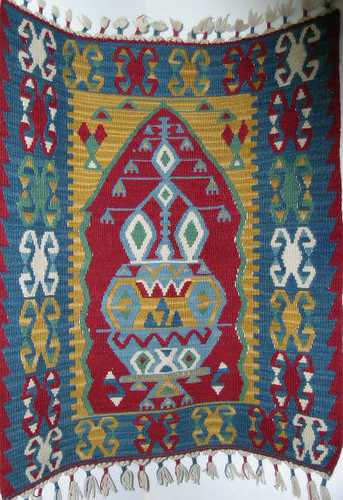
This kilim was purchased in Istanbul in October
2003, in the Turkish carpet "alley" in the heart of the Grand
Bazaar. It is a traditional prayer kilim, with natural dyes (for example,
the white is the natural color of the 100% wool material used for the
kilim and the brown is tobacco). The image depicted is the tree of life
in the center, surrounded by a border of scorpions. |
1. The Issue
A kilim is a flat-woven rug (though because of the artful nature of the kilim,
many are hung on the wall as show-pieces instead of being used as a floor-covering)
made in several regions of the world, including Turkey, Persia, and the Caucasus.
Making a kilim is a highly regarded folk art; kilims that are handmade with
natural dye and wool are the cultural norm. There is also a great deal of symbolism
in the patterns used in each design. Some kilims are even used as Muslim prayer
rugs. Because of the cultural aspects of these rugs, each region has its own
traditions revolving around colors, styles, and patterns. Because of the regional
nature of the differences in style, it is easy to identify the type of kilim
by aesthetics. This has led to a particular region in Turkey choosing to patent
their own brand of kilim.
2. Description
A kilim is a type of rug, but one that lays flat because there is no vertical
weave, or "pile." The pile is the main characteristic of rugs or carpets
that most people associate with typical rugs. Because it has no pile, oftentimes
a kilim may have no correct up-side or down-side and may be reversible.
Though each region has developed its own particular style of kilim, the Anatolian
region of Turkey has staked claim on the original. One particular style of Anatolian
kilim is the Afyon, which has been patented (TasteofTurkey.com). The full name
of both the city and the province in Western Anatolia where this particular
style of kilim originates is Afyonkarahisar (Kilim.com). Scraps of what may
be the predecessors to modern day kilims were found in that particular region
dating back to the 8th and 7th centuries B.C. (Kilim.com). These findings suggest
that all modern kilims may have emerged from this region.
Afyon kilims are 100% wool, with all-natural dyes, and completely handmade (TasteofTurkey.com).
These qualities are representative of the ideal kilim in any region, so there
are also stylistic qualities that set the Afyon kilim apart from the crowd (Lonely
Planet, Istanbul). The main colors used in an Afyon kilim are apricot,
pink, blue, green and yellow. The patterns are large geometric shapes, similar
on most Anatolian kilims, but with a signature fence or finger shape protruding
from them, called parmakli, which loosely translates to “with
fingers" (Kilim.com).
Regional differences between kilims outside of Turkey are easily determined
by plain sight. The Turkish, Persian, and Kurdish varieties of kilim are quite
similar, with sweeping geometric shapes including triangles and zig-zags. The
Persian seems to have smaller designs as compared to the bold, larger images
on the Turkish kilim. An expansive pictorial guide with descriptions of not
only tribes but regions in ancient Persian kilim design can be found here.
The following is an example of the difference between regional takes on the
same technique of rugmaking - with no vertical pile, flat-lying - with a comparison
between an Azeri kilim and a Turkish kilim:
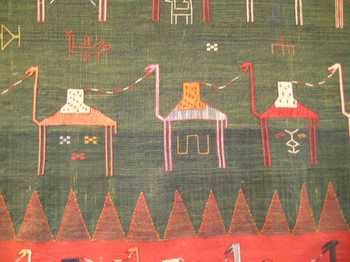
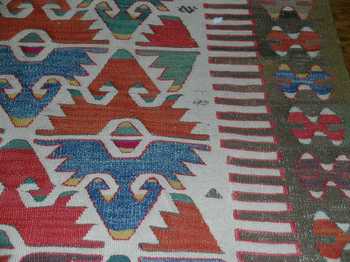
If you will note the Azeri kilim on the left portrays animals, most likely
camels, as they are seen. The Turkish kilim on the right also portrays animals,
but in an entirely different manner, with shapes that only hint as to the subjects
true appearance - a very abstract design. This is a style common to Islam because
of the general rules against idolaters. If you notice the green border on the
left, the shapes that line the edge are a depiction of scorpions, a common geometric
shape on Turkish kilims.
Coloring in the examples so far has been very natural, but there is a great
variety of color use. This kilim up close looks almost neon, and is very dark
with black detailing compared to the neutrals seen in the rest of the examples
here:
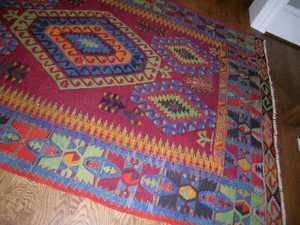
Kilim-use is not restricted only to rugs. As mentioned earlier, kilims are
often hung on the wall (both the Turkish kilim at the top of the page, and the
Azeri kilim immediately above are hung as display pieces). They are also made
as saddle covers, as seen here:
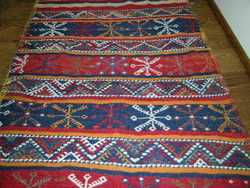
Oftentimes, because the process of creating a kilim is so specialized
and intense, and also made for the tourist industry, a flawed kilim is not worth
putting on display inside one of the many shops throughout Istanbul, especially
in the bazaars. The primary alternate use for a flawed kilim has been in the
form of pillows. The danger in this, though, has been that tourists to Turkey
have enjoyed the kilim pillows so much that they created a major market for
them, and now kilims in perfectly good condition are being dissected into squares
to be used to create pillowcases such as these:

With as many forms and varieties of kilims offered, it is hard
to come away from a trip to Turkey without one. The Turkish carpet merchants
are renowned for their sales abilities - though some might describe the merchants
as pushy and relentless. They will initially attempt to sell you a Turkish carpet,
larger and more expensive than a kilim. The obvious response would be to claim
poverty and lack of space for a 5 foot Turkish carpet. Then the salesman will
move on to kilims, the far more budget- and space-sensitive souvenir. And the
lucky tourist might walk away with more than a few kilims.
3. Related Cases
| Regional/Cultural Cases: |
|
| Egypt
|
This case centers around the effect of tourism on the
environment. Turkey is a gigantic destination for the tourism industry,
and along with other countries in that region, has enacted a heavy policy
restricting antiquities from leaving the borders |
| Mummy |
Egyptian mummies are part of the cultural history of
Egypt, much like the Turkish kilim is part of the cultural history of Turkey
(and also the surrounding region). |
| Ataturk
Dam |
Part of the kilim dispute/tension is that each area
has its own style and claim on the kilim. I’m sure the dispute over
natural resources is more pressing to those in the developing Middle East
region, but the concern over intellectual property is also vast, given the
relatively new and fairly artificial borders and nationalities. |
| Fabric/Textile Cases: |
|
| Africa
Textiles |
This involves anti-dumping laws and the fear that Sub-Saharan
Africa will "dump" its cheaper textiles into the US. This is a
very interesting related case with regard to the GI issue, because if and
when it is determined that cultural techniques in the realm of textiles
are intellectual property, the US will not be able to stop the influx of
foreign textiles. |
| Cashmere
|
This involves the raw materials that go into producing
kilims. Kilims, however, are generally made out of wool, very rarely goat
in the Balkans. It is a good prompt to examine how the basic materials affect
the end products. |
| Human Rights Cases: |
|
| Rugmark
|
This is a good related case because of the human rights
involved in the carpet industry. It is a good jumping off point to examine
the scope of human rights in a craft industry. The concern for child labor
is less real in the case of kilims, however, because they are not a mass-manufactured
item. |
| Nike
Child Labor |
This case involves Pakistan, in the same region as Turkey,
and child labor involving the manufacture of Nike soccer balls. |
4. Author and Date: Jessica Tacka (May 4, 2005)

5. Discourse and Status: Disagree
and Complete
6. Forum and Scope: National Patent
and Regional
7. Decision Breadth: 10+ Countries
across the Mideast and Asia also produce kilims.
8. Legal Standing: Law
The Afyon province's move to patent their techniques may encourage other regions
and countries to do the same. Certainly if one obscure province in Turkey can
place a patent on intellectual property, entire countries such as Turkey, Iran,
and Azerbaijan will be able to do the same. Far from being a restricting piece
of legislation, placing the kilims of different countries and regions under
legal protection will encourage proper attributions for the style and culture
of different kilims, as well as ensure the cultural traditions of each country
or region a long-term future.

Kilims are made across Turkey, but the patent on the Afyon kilim comes from
Anatolia, the region labeled in the center of the map:

9. Geographic Locations
a. Geographic Domain: Asia
b. Geographic Site: Mideast
c. Geographic Impact: Asia Mideast
10. Sub-National Factors: Yes
11. Type of Habitat: Dry - the necessary
environment to produce kilims is only one which encourages sheep farming, as
traditional kilims are made with 100% wool and natural dyes.

12. Type of Measure: Intellectual
Property
13. Direct v. Indirect Impacts:
Direct
14. Relation of Trade Measure to Environmental
Impact
a. Directly Related to Product: Yes, Rugs
b. Indirectly Related to Product: No
c. Not Related to Product: No
d. Related to Process: Yes, Intellectual Property
15. Trade Product Identification: Kilim
16. Economic Data
Turkey is hardly the world’s leader in textile imports. The issue at
stake in the Turkish kilim case, however, has nothing to do with industry, but
with craftsmanship. Available global trade data for the Turkish textile industry
falls under the umbrella term “textiles and apparel.” The two industries,
however similar, have a great variety of different characteristics. For example,
while human rights issues plague the apparel industry (particularly when designers
outsource to create their “discount” lines), human rights violations
exist in the textile industry, but are far less common. Recent cases (including
some listed on the TED database) with large American companies manufacturing
clothing abroad in sweatshops to cut cost can explain some of the reason that
the apparel industry is being watched more closely for human rights violations
than the textile industry. There is a larger market for apparel overall, so
the tempation to increase profit by underpaying child laborers abroad is also
greater. The craftsmanship that a buyer looks for when shopping for the perfect
Turkish kilim has nearly nothing to do with industry, manufacturing, and high-intensity
exports and imports.
Kilims are primarily exported by individual tourists. Each kilim rug seems to
have a story attached to it; perhaps there was a deal on several different items
in a marketplace, a memorable carpet vendor, or merely a case of love at first
sight. But kilims simply represent a tiny fraction of the large textile industry
that helps support a burgeoning Turkish economy.
| 2003 Turkish Textile
Exports (WTO Figures) |
$5.255 billion |
11% of Turkish Exports |
| 1997 Textile Imports
(International Trade Forum Figures) |
European Union Total |
Germany, Italy, UK combined |
| |
63% |
45% + |
These figures change significantly as the competition between cheaper, manufactured
products and quality durable craft goods ebbs and flows.
17. Impact of Trade Restriction: High
Arguments have been made that the Anatolian region of Turkey produces the best
kilims in the world, far surpassing the half a dozen or more countries in that
region of the world who also call kilim a cultural handicraft - though several
other countries make equal claims on the kilim's origin. One small city in Anatolia
has even gone so far as to patent their own distinct kilim – the Afyon
kilim. Afyon kilims fall under the “Aegean Region” of kilim production,
or the area around the sea that Homer immortalized in his works, The Illiad
and The Odyssey. Even if the only reaction an American has to the area
is based upon an experience with required reading in high school, the Aegean
Sea conjures up a romanticized look at the land of the classics, the modern
land of the Turks, and the land of the Afyon kilim.
Aside from “finger-like” protrusions from each of the geometric
shapes used in weaving the kilim, the Afyon kilim has several other distinct
characteristics:
| "Contemporary
Afyon kilims are made in plainweave or slitweave, and the primary colors
employed are apricot, pink, blue, green and yellow. The hues are mainly
light, but some new village kilims tend to be garish unless faded in the
sun. Wool and mohair are produced in the region and the wool used for kilims
is of medium and fine quality." (Kilim.com) |
With such precise qualities identifying an Afyon kilim, it is easy to see why
there was a move to patent the design.
Ten years ago, GATT began a process of integrating clothing and textiles as
a category into the Agreement. The long and complicated process to implement
this task involved a “no dumping” policy, because there was a concern
that overall imports of a certain product might enter a “country in such
increased quantities as to cause serious damage — or to threaten it —
to the relevant domestic industry.” This all occurred during the Uruguay
Round of negotiations, creating the “Agreement on Textiles and Clothing”
(WTO).
This January (2005) was the end of the ten-year period allotted by the Uruguay
Round to bring textiles and clothing under the general agreements (WTO). Starting
in January, there are no more quotas placed on textiles outside of regular WTO/GATT
agreements. This is particularly important to developing countries like Turkey,
where an object like a kilim is a textile, but also part of culture. Now any
textiles and clothing can be traded as any other product, and this evens the
playing field for all the developing countries in the Orient who have large
foundations of trade based on textiles.
The WTO/GATT rules regarding textiles and clothing can be explored in great
depth, however they have little actual relevance to the Turkish kilim as a GI
because a kilim is ultimately a handicraft. Its creation is a skill that is
passed down through families, tribes, and regional cultures. The more important
legal issue to focus on is the patent. As of right now, the Afyon kilim is the
only style of kilim to receive any legal protection whatsoever, but as demonstrated
in the pictures in the description section, stylistic issues surrounding kilims
are vast and special.
The Afyon patent is what will inevitably and thankfully be able to prevent
a foreign-based distributor from “pillaging” the stylistic elements
of the Afyon kilim for his own, and selling it to people who have no clue as
to the culture of what they are purchasing. In this modern era of globalization,
patenting something that has been part of a culture for centuries (the oldest
kilims discovered, were found in the Afyon province) sounds cold initially.
But to take a step forward into a century of no borders or boundaries, placing
a patent is a reasonable way to ensure the future of cultural traditions.
18. Industry Sector: Textiles and
Apparel
19. Exporters and Importers: Specific
data on the import and export of kilims is not available, but kilims as a textile,
fall under the WTO data collection "textiles and apparel" category.
WTO data indicates that the largest exporters and importers of textiles fall
mainly in the developing world, especially Asia. Their top 10 importers and
exporters according to 2003 trade data are:
| Exports - Country |
Value (Billions of Dollars) |
| China |
26.90 |
| European Union |
26.37 |
| Hong Kong |
13.08 |
domestic exports |
0.76 |
re-exports |
12.33 |
| United States |
10.92 |
| Republic of Korea |
10.12 |
| Taipei, Chinese |
9.32 |
| India |
6.51 |
| Japan |
6.43 |
| Pakistan |
5.81 |
| Turkey |
5.21 |
| Imports - Country |
Value (billions of dollars) |
| EU |
19.97 |
| US |
18.29 |
| China |
14.22 |
| Hong Kong, China |
12.93 |
retained imports |
0.60 |
| Mexico |
5.46 |
| Japan |
5.04 |
| Canada |
3.86 |
| Turkey |
3.42 |
| Poland |
3.04 |
| Republic of Korea |
2.94 |
These figures are easy to analyze, as most of the exporters are from the developing
world and/or Asia. What this list fails to recognize though is the share of
trade as a percentage of the individual nations’ total exports. These
two lists are composed of a lot of large economic countries. The following table
shows the top five exporters as a percentage of their total exports:
| Exporters |
Value (millions) |
Percentage of Total Exports |
| Pakistan |
$5811 |
48.7% |
| Nepal |
165 |
22.4% |
| Macao, China |
303 |
11.7% |
| India |
6510 |
11.6% |
| Turkey |
5244 |
11.3% |
Economically, the first two data sets make perfect sense. But because textiles
are primarily a developing country’s industry, the second table shows
clearly that the developing countries, particularly in Asia, depend on textile
exports for their economic stability. As you can see, Turkey is on all three
of these lists. Textiles and apparel are clearly a large part of its economy.

20. Environmental Problem Type:
Culture
21. Name, Type, and Diversity of Species: N/A
22. Resource Impact and Effect:
Low and Product
23. Urgency and Lifetime: Low and
Hundreds of Years
24. Substitutes: Persian Rugs, Persian/Azeri/Caucasian/Kurdish
Kilims

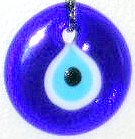 VI. Other Factors
VI. Other Factors
25. Culture: Yes
26. Trans-Boundary Issues: Yes
27. Rights: Yes
It has been discussed so far that the ideal qualities that a kilim connoisseur
looks for when rug-shopping are that the material used is 100% cotton, that
the dyes are all natural, and most importantly that the kilim is entirely handmade.
The human element involved in making a kilim is what makes owning one so special.
Besides the cultural aspects of kilims, which have been discussed in detail
throughout this page, the human rights concerns are a crucial issue to explore.
If patenting kilim styles and techniques catches on in other regions and countries,
the demand for "authentic" and documented kilims has the potential
to rise significantly, and the case for human rights always becomes critical
in high-demand industry sectors. So what of the people making the rugs?
Rug-making has traditionally been a job for single, unwed females in Turkey
(Lotozo). This can be an advantage to young Turkish women, who are not under
pressure to be married off as soon as possible once they are capable of providing
for themselves, and are “no longer a mouth to feed” (Lotozo). Women
have been dominating the textile industry as a whole since shortly after Turkish
independence, when around 1 million war widows had been left to fend for themselves
(Seidman 3).
There is always a danger, as with any industry, of worker exploitation in the
form of sweatshops and child labor. Compulsory education laws have convinced
some that child labor is not a problem in Turkey as it is in other rug-making
nations such as Nepal, Pakistan or India (Lotozo). But recent talks with the
EU have sparked reports on human rights conditions in Turkey, citing improvements
but not eliminations of honor killings, police torture, and child labor (Brown).
The official counts on child labor are difficult to ascertain because of the
large number of unregistered workers in the industry. Data is collected under
the umbrella term “apparel and textile” industry, and it is more
likely that the majority of unregistered workers are in the apparel industry,
which is also the more frequent labor rights offender (Seidman, 4). The benefit
of the data that has been collected, however, is that it includes unpaid family
workers and “home-work” (most artisan goods, such as carpets, work
in homes), so it accounts for the cultural aspects of the industry. The good
news is that 6-11 year olds are rarely in the labor force, with an official
employment rate of 1.3% in 1994 (Seidman 5). For 12-17 year olds, more females
enter the textile industry with 35% of those who work outside the home as opposed
to 14% of males (Seidman 5).
Since 1974, there has been a minimum wage law in Turkey, and Turkey’s
manufacturing wages fall in the mid-range globally (Seidman 5). Males would
most likely receive a gender premium of around 15%, but women still dominate
the industry (Seidman 5).
When shopping for a kilim, bear in mind that there is more to your purchase
than quality and receiving a good deal. Ask to see documentation on the rugs,
and ask your hotel concierge for a recommendation on a labor-approved rug merchant.
If possible, shop for your rug as “close to the source” as possible;
trading strictly with the craft-artist ensures that your rug has been made by
a willing adult, and also that the artist is receiving a direct wage from the
buyer, as opposed to a limited monthly wage from a business owner ("If
You Follow"). Labor violations are sure to be reduced by leaps and bounds
as Turkey continues to negotiate with the EU on membership, so in the future,
the rug and kilim industry could be entirely free of human rights concerns.
28. Relevant Literature & Attributions
Many thanks to Mr. Rob Quartel for allowing
his extensive kilim collection to be photographed for this project. The
Turkish kilim at the very top of this page is the only rug not to come
from his collection. All photographs are original, except for the map
and flag which both came from the CIA website. |
“Background Statistical Information with Respect to Trade in Textiles
and Clothing.” World Trade Organization. 20 September 2004.
Brown, Anthony and Suna Erdem. “Turkey Takes a Giant Step Towards EU
Membership.” The Times (London). Lexis-Nexis. October 7, 2004. (13 February
2005).
Campbell, Verity and Tom Brosnahan. Istanbul. Lonely Planet Publications:
Oakland, CA: Lonely Planet Publications, 2002.
Hull, Alastair. Kilim: The Complete Guide: History, Pattern, Technique,
Identification. San Francisco: Chronicle Books, 1993.
“If
You Follow the Passionate Collector’s Grail.” Star Tribune.
June 16, 2002. (13 February 2005).
Kilim.com
Lotozo, Eils. “Magic Carpet Ride” Philadelphia Inquirer. January
20, 2005. Lexis-Nexis (13 February 2005).
TasteofTurkey.com
Seidman, Lisa A. “Textile
Workers in Turkey 1922-2003.” November 2004. (13 February 2005).
“The Culture of Turkish
Carpets”
"Traditional Carpets and Kilims: Trade in Cultural Heritage." International
Trade Forum. April 1999.
WTO - Agreement
on Textiles and Clothing
**Horizontal Lines from: http://www.grsites.com**

This is a Turkish evil eye protector. One is hanging
up in nearly every household or shop in Istanbul and throughout Turkey.
This particular evil eye is hanging off of a carpet, illustrating the
importance of rugs and carpets in Turkish culture.
|
5/2005



 I. Identification
I. Identification





